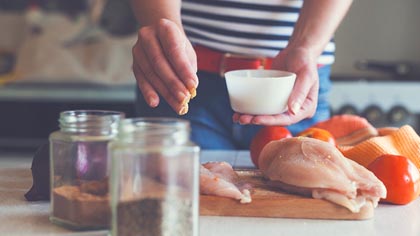 If you’re serious about maintaining a balanced diet with the right ratios of nutrients to help you meet your goals, you’ve probably heard the notion that you should practice controlling your portion sizes.
If you’re serious about maintaining a balanced diet with the right ratios of nutrients to help you meet your goals, you’ve probably heard the notion that you should practice controlling your portion sizes.
That’s because when it comes to weight management and healthy nutrition, the amounts of foods you eat can and do matter. Here’s a simple way to judge serving sizes just by looks alone.
Portion Sizes and Servings
If you’re measuring or counting any specific components of your diet – protein, sugars, calories, sodium, fiber, etc. – you know that packages and guides provide information per serving. So, to get a real count on your intake, you need to know what a serving actually amounts to, and then you can choose your portions from there.
To be clear about the difference, keep in mind that a serving is a specific amount of food, like an eight-ounce filet or a cup of berries, while the portion size is simply the amount of food you choose to eat, whether that’s more or less than the serving size being counted. For example, a restaurant portion of fries might be three times the “serving” size you’re counting. That would mean three times the sodium, fat, calories and carbs than you might think you are taking in.
Do I Have to Measure Portion Sizes?
It’s not always critical to have an exact measurement for your portions. For example, most people can enjoy unlimited portions of green vegetables with little drawback. If you’re working on weight loss, you might choose to skip all portions of treats like ice cream or pasta. However, if you’re tracking your nutrient content, you’ll want to know how many omega-3 fatty acids you’re getting in a portion of fish, or if you’re actually eating seven servings of produce per day.
Still, no one wants to spend a lot of time and energy weighing, measuring or looking up serving sizes. Taking an informed look at the sizes and shapes of your foods will go a long way to helping you eat healthy and manage portion control without a hassle. Here is an easy guide for some of the most common portion size recommendations.
“Handy” Guide to Portion Sizes
One of the simplest ways to gauge the servings of the foods you’re eating is to use your hands as a measuring tool. It’s easy to memorize the basics of this method, and you’ll never be without your portion sizer!
Protein: Choose meat portions the size of the palm of your hand, chicken breasts the size of your palm to your middle knuckles and fish the size of your palm up to fingertips.
Starch: For pasta, rice or potato servings, choose a portion the size of your fist.
Fruits or vegetables: The size of your fist works for a portion of these foods as well.
Salad: A typical salad portion is two cups—think of filling both hands held wide open.
Cheese: An ounce of cheese is a chunk the size of one finger.
Nut Butter: A typical portion would be a scoop about the size of your thumb.
Butter: The tip of your finger is about the size of a pat, or serving of butter.
Snacks: A small handful of nuts, crackers or similar will be about a half cup, which is plenty.



